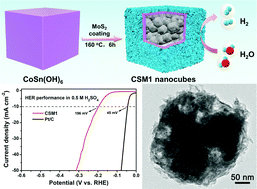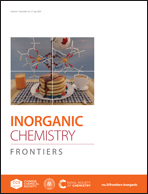Synthesis of CoS2/SnO2@MoS2 nanocube heterostructures for achieving enhanced electrocatalytic hydrogen evolution in acidic media†
Abstract
Heterostructures with multiple electrocatalytically active components to simultaneously satisfy electrochemical and structural requirements have recently been regarded as materials with high catalytic activity in the hydrogen evolution reaction (HER). Herein, hybrid structures of CoS2/SnO2@MoS2 (CSM1) nanocubes are synthesized via a fast template-engaged hydrothermal treatment employing perovskite hydroxide CoSn(OH)6 nanocubes as precursor templates. The self-template strategy has the ability to construct samples with a multicomponent structure, including highly catalytically active components of CoS2 and MoS2 as well as highly conductive SnO2, with a porous interior. Benefiting from the merits of appropriate composition and well-retained porous nanocube structure, the CSM1 nanocubes exhibit the HER performance with a desired overpotential of 196 mV at a current density of 10 mA cm−2, a small Tafel slope of 69 mV dec−1 and long-time stability in acidic media. This protocol sheds light on designing a rational structure with prominent electrocatalytic activity and stability in energy-related applications.



 Please wait while we load your content...
Please wait while we load your content...